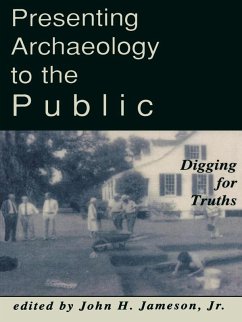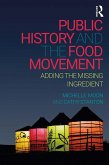Presenting Archaeology to the Public (eBook, PDF)
Digging for Truths
Redaktion: Jameson Jr., John H.
37,95 €
37,95 €
inkl. MwSt.
Sofort per Download lieferbar

19 °P sammeln
37,95 €
Als Download kaufen

37,95 €
inkl. MwSt.
Sofort per Download lieferbar

19 °P sammeln
Jetzt verschenken
Alle Infos zum eBook verschenken
37,95 €
inkl. MwSt.
Sofort per Download lieferbar
Alle Infos zum eBook verschenken

19 °P sammeln
Presenting Archaeology to the Public (eBook, PDF)
Digging for Truths
Redaktion: Jameson Jr., John H.
- Format: PDF
- Merkliste
- Auf die Merkliste
- Bewerten Bewerten
- Teilen
- Produkt teilen
- Produkterinnerung
- Produkterinnerung

Bitte loggen Sie sich zunächst in Ihr Kundenkonto ein oder registrieren Sie sich bei
bücher.de, um das eBook-Abo tolino select nutzen zu können.
Hier können Sie sich einloggen
Hier können Sie sich einloggen
Sie sind bereits eingeloggt. Klicken Sie auf 2. tolino select Abo, um fortzufahren.

Bitte loggen Sie sich zunächst in Ihr Kundenkonto ein oder registrieren Sie sich bei bücher.de, um das eBook-Abo tolino select nutzen zu können.
In the face of increasing public interest and demand for information, archaeologists are collaborating with historians, museum curators, and exhibit designers to devise the best strategies for translating archaeological information to the public. This book opens doors for public involvement. It highlights successful case studies in which specialists have provided with the opportunity and necessary tools for learning about archaeology. Little Big Horn, Sabino Canyon, Monticello, and Poplar Forest are just a few of the historical sites featured.
- Geräte: PC
- mit Kopierschutz
- eBook Hilfe
- Größe: 15.89MB
Andere Kunden interessierten sich auch für
![Presenting the Past (eBook, PDF) Presenting the Past (eBook, PDF)]() Larry J. ZimmermanPresenting the Past (eBook, PDF)27,95 €
Larry J. ZimmermanPresenting the Past (eBook, PDF)27,95 €![Presenting Archaeology in Court (eBook, PDF) Presenting Archaeology in Court (eBook, PDF)]() Presenting Archaeology in Court (eBook, PDF)24,95 €
Presenting Archaeology in Court (eBook, PDF)24,95 €![A Practitioner's Guide to Public Archaeology (eBook, PDF) A Practitioner's Guide to Public Archaeology (eBook, PDF)]() A Practitioner's Guide to Public Archaeology (eBook, PDF)23,95 €
A Practitioner's Guide to Public Archaeology (eBook, PDF)23,95 €![The Oxford Handbook of Public Heritage Theory and Practice (eBook, PDF) The Oxford Handbook of Public Heritage Theory and Practice (eBook, PDF)]() The Oxford Handbook of Public Heritage Theory and Practice (eBook, PDF)64,95 €
The Oxford Handbook of Public Heritage Theory and Practice (eBook, PDF)64,95 €![Protecting the Objects and Serving the Public (eBook, PDF) Protecting the Objects and Serving the Public (eBook, PDF)]() Protecting the Objects and Serving the Public (eBook, PDF)38,95 €
Protecting the Objects and Serving the Public (eBook, PDF)38,95 €![Archaeological Displays and the Public (eBook, PDF) Archaeological Displays and the Public (eBook, PDF)]() Archaeological Displays and the Public (eBook, PDF)46,95 €
Archaeological Displays and the Public (eBook, PDF)46,95 €![Public History and the Food Movement (eBook, PDF) Public History and the Food Movement (eBook, PDF)]() Michelle MoonPublic History and the Food Movement (eBook, PDF)42,95 €
Michelle MoonPublic History and the Food Movement (eBook, PDF)42,95 €-
-
-
In the face of increasing public interest and demand for information, archaeologists are collaborating with historians, museum curators, and exhibit designers to devise the best strategies for translating archaeological information to the public. This book opens doors for public involvement. It highlights successful case studies in which specialists have provided with the opportunity and necessary tools for learning about archaeology. Little Big Horn, Sabino Canyon, Monticello, and Poplar Forest are just a few of the historical sites featured.
Produktdetails
- Produktdetails
- Verlag: Bloomsbury eBooks US
- Seitenzahl: 1
- Erscheinungstermin: 4. Februar 1997
- Englisch
- ISBN-13: 9798216212034
- Artikelnr.: 75137935
- Verlag: Bloomsbury eBooks US
- Seitenzahl: 1
- Erscheinungstermin: 4. Februar 1997
- Englisch
- ISBN-13: 9798216212034
- Artikelnr.: 75137935
- Herstellerkennzeichnung Die Herstellerinformationen sind derzeit nicht verfügbar.
National Park Service, United States
Chapter 1 Acknowledgements
Chapter 2 Foreword by John H. Jameson, Jr. and John E. Ehrenard
Chapter 3 Introduction, by John H. Jameson, Jr.
Part 4 One: Background
Chapter 5 1. Presenting the Past: A Framework for Discussion, by Peter G.
Stone
Chapter 6 2. The Archaeological Site as an Interpretive Environment, by
Parker B. Potter, Jr.
Chapter 7 3. Locating Truths on Archaeological Sites, by Parker B. Potter,
Jr. and Nancy Jo Chabot
Chapter 8 4. Generalized Versus Literal Interpretation, by Stanley South
Part 9 Two: Strategies that Work
Chapter 10 5. Successfully Integrating the Public into Research: Crow
Canyon Archaeological Center, by Margaret A. Heath
Chapter 11 6. The Role of Public Participation: Arizona's Public
Archaeology Program, by Teresa L. Hoffman
Chapter 12 7. Sites without Sights: Interpreting Closed Excavations, by
Karen Lee Davis
Part 13 Three: Interpreting Archaeology in Cities
Chapter 14 8. The Past through Tomorrow: Interpreting Toronto's Heritage to
a Multi-cultural Pubic, by Karolyn E. Smardz
Chapter 15 9. Ancient and Modern United: Archaeological Exhibits in Urban
Plazas, by Sherene Baugher and Diana Dizerga Wall
Chapter 16 10. The Evolution of Interpretation: The Charleston Place Site,
by Nichols Honerkamp and Martha A. Zierden
Part 17 Four: Interpreting Archaeology at Museums, Parks, and Sites
Chapter 18 11. Public Archaeology at Cahokia, by William R. Iseminger
Chapter 19 12. Interpreting Cultural Resources: Hatzic Site, by David
Pokotylo and Gregory Brass
Chapter 20 13. Putting people Back into the Landscape: Sabino Canyon, by
Stephanie M. Whittlesey and Mary Farrell
Chapter 21 14. Archaeology and Interpretation at Monticello and Poplar
Forest, by Barbara J. Heath
Chapter 22 15. The Interpretation of Slavery: Mount Vernon, Monticello, and
Colonial Williamsburg, by Mark D. Bograd
Chapter 23 16. Museum in the Making: The Morven Project, by Rebecca Yamin
Chapter 24 17. Archaeological Preservation: Drayton Hall, by Meffett B.
Lavin
Chapter 25 18. Interpreting Archaeology at Little Bighorn, by Douglas D.
Scott
Chapter 26 19. The Archaeology of Billy the Kid, by David T. Kirkpatrick
Chapter 27 Bibliography
Chapter 28 About the Authors
Chapter 29 Index
Chapter 2 Foreword by John H. Jameson, Jr. and John E. Ehrenard
Chapter 3 Introduction, by John H. Jameson, Jr.
Part 4 One: Background
Chapter 5 1. Presenting the Past: A Framework for Discussion, by Peter G.
Stone
Chapter 6 2. The Archaeological Site as an Interpretive Environment, by
Parker B. Potter, Jr.
Chapter 7 3. Locating Truths on Archaeological Sites, by Parker B. Potter,
Jr. and Nancy Jo Chabot
Chapter 8 4. Generalized Versus Literal Interpretation, by Stanley South
Part 9 Two: Strategies that Work
Chapter 10 5. Successfully Integrating the Public into Research: Crow
Canyon Archaeological Center, by Margaret A. Heath
Chapter 11 6. The Role of Public Participation: Arizona's Public
Archaeology Program, by Teresa L. Hoffman
Chapter 12 7. Sites without Sights: Interpreting Closed Excavations, by
Karen Lee Davis
Part 13 Three: Interpreting Archaeology in Cities
Chapter 14 8. The Past through Tomorrow: Interpreting Toronto's Heritage to
a Multi-cultural Pubic, by Karolyn E. Smardz
Chapter 15 9. Ancient and Modern United: Archaeological Exhibits in Urban
Plazas, by Sherene Baugher and Diana Dizerga Wall
Chapter 16 10. The Evolution of Interpretation: The Charleston Place Site,
by Nichols Honerkamp and Martha A. Zierden
Part 17 Four: Interpreting Archaeology at Museums, Parks, and Sites
Chapter 18 11. Public Archaeology at Cahokia, by William R. Iseminger
Chapter 19 12. Interpreting Cultural Resources: Hatzic Site, by David
Pokotylo and Gregory Brass
Chapter 20 13. Putting people Back into the Landscape: Sabino Canyon, by
Stephanie M. Whittlesey and Mary Farrell
Chapter 21 14. Archaeology and Interpretation at Monticello and Poplar
Forest, by Barbara J. Heath
Chapter 22 15. The Interpretation of Slavery: Mount Vernon, Monticello, and
Colonial Williamsburg, by Mark D. Bograd
Chapter 23 16. Museum in the Making: The Morven Project, by Rebecca Yamin
Chapter 24 17. Archaeological Preservation: Drayton Hall, by Meffett B.
Lavin
Chapter 25 18. Interpreting Archaeology at Little Bighorn, by Douglas D.
Scott
Chapter 26 19. The Archaeology of Billy the Kid, by David T. Kirkpatrick
Chapter 27 Bibliography
Chapter 28 About the Authors
Chapter 29 Index
Chapter 1 Acknowledgements
Chapter 2 Foreword by John H. Jameson, Jr. and John E. Ehrenard
Chapter 3 Introduction, by John H. Jameson, Jr.
Part 4 One: Background
Chapter 5 1. Presenting the Past: A Framework for Discussion, by Peter G.
Stone
Chapter 6 2. The Archaeological Site as an Interpretive Environment, by
Parker B. Potter, Jr.
Chapter 7 3. Locating Truths on Archaeological Sites, by Parker B. Potter,
Jr. and Nancy Jo Chabot
Chapter 8 4. Generalized Versus Literal Interpretation, by Stanley South
Part 9 Two: Strategies that Work
Chapter 10 5. Successfully Integrating the Public into Research: Crow
Canyon Archaeological Center, by Margaret A. Heath
Chapter 11 6. The Role of Public Participation: Arizona's Public
Archaeology Program, by Teresa L. Hoffman
Chapter 12 7. Sites without Sights: Interpreting Closed Excavations, by
Karen Lee Davis
Part 13 Three: Interpreting Archaeology in Cities
Chapter 14 8. The Past through Tomorrow: Interpreting Toronto's Heritage to
a Multi-cultural Pubic, by Karolyn E. Smardz
Chapter 15 9. Ancient and Modern United: Archaeological Exhibits in Urban
Plazas, by Sherene Baugher and Diana Dizerga Wall
Chapter 16 10. The Evolution of Interpretation: The Charleston Place Site,
by Nichols Honerkamp and Martha A. Zierden
Part 17 Four: Interpreting Archaeology at Museums, Parks, and Sites
Chapter 18 11. Public Archaeology at Cahokia, by William R. Iseminger
Chapter 19 12. Interpreting Cultural Resources: Hatzic Site, by David
Pokotylo and Gregory Brass
Chapter 20 13. Putting people Back into the Landscape: Sabino Canyon, by
Stephanie M. Whittlesey and Mary Farrell
Chapter 21 14. Archaeology and Interpretation at Monticello and Poplar
Forest, by Barbara J. Heath
Chapter 22 15. The Interpretation of Slavery: Mount Vernon, Monticello, and
Colonial Williamsburg, by Mark D. Bograd
Chapter 23 16. Museum in the Making: The Morven Project, by Rebecca Yamin
Chapter 24 17. Archaeological Preservation: Drayton Hall, by Meffett B.
Lavin
Chapter 25 18. Interpreting Archaeology at Little Bighorn, by Douglas D.
Scott
Chapter 26 19. The Archaeology of Billy the Kid, by David T. Kirkpatrick
Chapter 27 Bibliography
Chapter 28 About the Authors
Chapter 29 Index
Chapter 2 Foreword by John H. Jameson, Jr. and John E. Ehrenard
Chapter 3 Introduction, by John H. Jameson, Jr.
Part 4 One: Background
Chapter 5 1. Presenting the Past: A Framework for Discussion, by Peter G.
Stone
Chapter 6 2. The Archaeological Site as an Interpretive Environment, by
Parker B. Potter, Jr.
Chapter 7 3. Locating Truths on Archaeological Sites, by Parker B. Potter,
Jr. and Nancy Jo Chabot
Chapter 8 4. Generalized Versus Literal Interpretation, by Stanley South
Part 9 Two: Strategies that Work
Chapter 10 5. Successfully Integrating the Public into Research: Crow
Canyon Archaeological Center, by Margaret A. Heath
Chapter 11 6. The Role of Public Participation: Arizona's Public
Archaeology Program, by Teresa L. Hoffman
Chapter 12 7. Sites without Sights: Interpreting Closed Excavations, by
Karen Lee Davis
Part 13 Three: Interpreting Archaeology in Cities
Chapter 14 8. The Past through Tomorrow: Interpreting Toronto's Heritage to
a Multi-cultural Pubic, by Karolyn E. Smardz
Chapter 15 9. Ancient and Modern United: Archaeological Exhibits in Urban
Plazas, by Sherene Baugher and Diana Dizerga Wall
Chapter 16 10. The Evolution of Interpretation: The Charleston Place Site,
by Nichols Honerkamp and Martha A. Zierden
Part 17 Four: Interpreting Archaeology at Museums, Parks, and Sites
Chapter 18 11. Public Archaeology at Cahokia, by William R. Iseminger
Chapter 19 12. Interpreting Cultural Resources: Hatzic Site, by David
Pokotylo and Gregory Brass
Chapter 20 13. Putting people Back into the Landscape: Sabino Canyon, by
Stephanie M. Whittlesey and Mary Farrell
Chapter 21 14. Archaeology and Interpretation at Monticello and Poplar
Forest, by Barbara J. Heath
Chapter 22 15. The Interpretation of Slavery: Mount Vernon, Monticello, and
Colonial Williamsburg, by Mark D. Bograd
Chapter 23 16. Museum in the Making: The Morven Project, by Rebecca Yamin
Chapter 24 17. Archaeological Preservation: Drayton Hall, by Meffett B.
Lavin
Chapter 25 18. Interpreting Archaeology at Little Bighorn, by Douglas D.
Scott
Chapter 26 19. The Archaeology of Billy the Kid, by David T. Kirkpatrick
Chapter 27 Bibliography
Chapter 28 About the Authors
Chapter 29 Index







